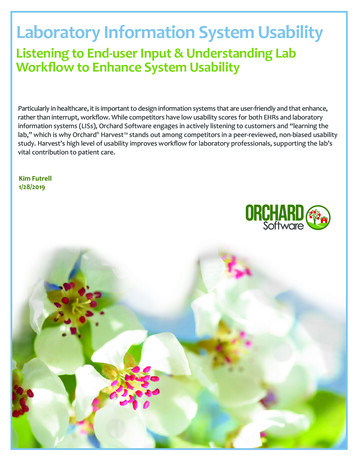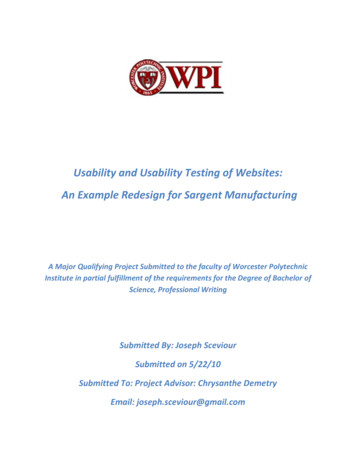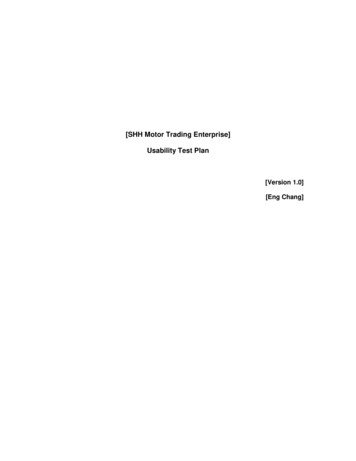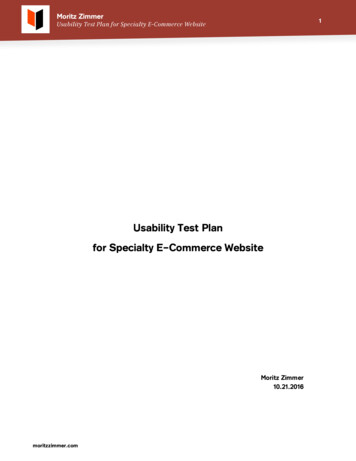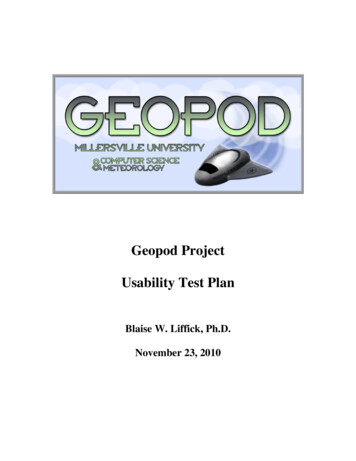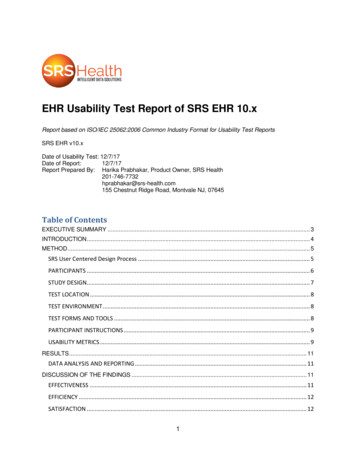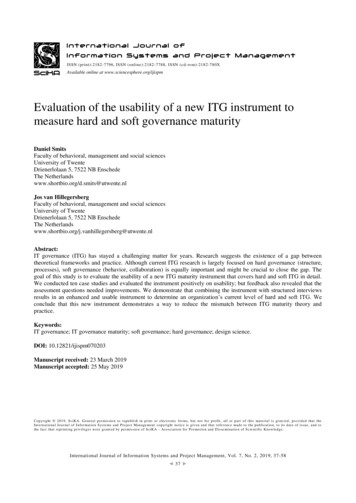
Transcription
ISSN (print):2182-7796, ISSN (online):2182 -7788, ISSN (cd-ro m):2182-780XAvailable online at www.sciencesphere.org/ijispmEvaluation of the usability of a new ITG instrument tomeasure hard and soft governance maturityDaniel SmitsFaculty of behavioral, management and social sciencesUniversity of TwenteDrienerlolaan 5, 7522 NB EnschedeThe Netherlandswww.shortbio.org/d.smits@utwente.nlJos van HillegersbergFaculty of behavioral, management and social sciencesUniversity of TwenteDrienerlolaan 5, 7522 NB EnschedeThe ente.nlAbstract:IT governance (ITG) has stayed a challenging matter for years. Research suggests the existence of a gap betweentheoretical frameworks and practice. Although current ITG research is largely focused on hard governance (structure,processes), soft governance (behavior, collaboration) is equally important and might be crucial to close the gap. Thegoal of this study is to evaluate the usability of a new ITG maturity instrument that covers hard and soft ITG in detail.We conducted ten case studies and evaluated the instrument positively on usability; but feedback also revealed that theassessment questions needed improvements. We demonstrate that combining the instrument with structured interviewsresults in an enhanced and usable instrument to determine an organization’s current level of hard and soft ITG. Weconclude that this new instrument demonstrates a way to reduce the mismatch between ITG maturity theory andpractice.Keywords:IT governance; IT governance maturity; soft governance; hard governance; design science.DOI: 10.12821/ijispm070203Manuscript received: 23 March 2019Manuscript accepted: 25 May 2019Copyr ight 2019, SciKA. General per missio n t o republish in pr int or elect ronic forms, but not for profit , all or part of t his mat er ial is gran t ed, provided t hat t heInt ernat ional Jour nal o f I nfor mat io n S yst ems and Pro ject Manage ment copyr ight notice is given and t hat refe rence made t o t he publicat ion, t o it s dat e of issue, and t ot he fact t hat reprint ing pr ivileges were grant ed by per miss io n o f SciKA - Associat ion for Pro mot ion and D isseminat io n o f Scient ific Knowledge.International Journal of Information Systems and Project Management, Vol. 7, No. 2, 2019, 37-58 37
Evaluation of the usability of a new ITG instrument to measure hard and soft governance maturity1. IntroductionWhen IT governance (ITG) or corporate governance go awry, “the results can be devastating” [1]. The bankruptcy ofEnron in 2001 and other scandals at Tyco, Global Crossing, WorldCom and Xerox resulting in the enactment in theUnited States of the Sarbanes-Oxley Act are just a few examples. Employees, customers, suppliers and local societiessuffered severe losses owing to managers driven by the possibilities of creating personal wealth through dramaticincreases in the market prices of their shares [2].The impact of ITG on firm performance have been well-established in previous studies, yet there remains a gapexplaining exactly how ITG influences firm performance [1]. ITG is positively related to business performance throughIT and business process relatedness [3], [4]. Weill and Ross [5] present another excellent example of the linkagebetween ITG and corporate governance with corporate and IT decision-making. A third example comprises therelationship between corporate governance and ITG of Borth and Bradley [6], in which ITG is presented as one of thekey assets to govern.Improving ITG is difficult because it is a challenging, complex topic. ITG is complex because it is not only aboutorganizational processes and structures but about human behavior too. We look at ITG from two perspectives: anorganizational perspective referred to as “hard governance” and a social perspective referred to as “soft governance”. Intraditional ITG research and frameworks the main focus was hard governance, sometimes defined as “structures andprocesses”. Social elements were not completely out of focus but many researchers favored generalizations like “socialintegration” [7] or “relational mechanisms” [8]. The social or human interactions in organizations are much morecomplex than organizational structures and processes and need at least the same amount of consideration in models orframeworks. This rarely happens in ITG research. This however is the focus of our research and the distinction betweenhard and soft governance is becoming more common in ITG research [9]-[14].The purpose of this study is to demonstrate and evaluate the usability of a new ITG instrument to measure ITG maturityin an organization. This is an assessment instrument that can be used to measure hard and soft ITG maturity in detail.Our approach is grounded in the assumption that improving “ITG maturity” results in improving ITG and thus firmperformance.This paper is organized as follows. This section introduces the purpose of this study. The next section introduces thetopics of hard and soft ITG and ITG maturity. Section 3 presents the research methodology. The results of the casestudies are described in Section 4. Section 5 covers the discussion. The conclusion, limitations and implications forfuture research are included in Section 6.2. IT governanceIn this section we introduce hard and soft ITG and ITG maturity.2.1 Hard and soft IT governanceITG is a relatively new topic [8], with the first publications appearing in the late 1990s. Although a considerable bodyof literature on ITG exists, definitions of ITG in the literature vary considerably [15], [16]. There simply does not seemto be a common body of ITG knowledge or a widely used ITG framework. An analysis of the ITG literature reveals thatsix streams of thought can be distinguished [17]. Four ITG streams differ in scope: “IT Audit”, “Decision making”,“Part of corporate governance, conformance perspective”, and “Part of corporate governance, performanceperspective”. The last two streams differ in the direction in which ITG works: “Top down” and “Bottom up”.In practice, organizations use all kinds of frameworks or methods for ITG. Frameworks are the most important enablersfor effective ITG [18]. A variety of frameworks devised for improving ITG exists [19]. The list of frameworksfrequently used for ITG vary considerably, as can be seen in several global surveys from the ITGI addressed to 749CEO-/CIO-level executives in 23 countries [18], [20]. Best practice frameworks are the most important enablers forInternational Journal of Information Systems and Project Management, Vol. 7, No. 2, 2019, 37-58 38
Evaluation of the usability of a new ITG instrument to measure hard and soft governance maturityeffective ITG. Other enablers include toolkits, benchmarking, certifications, networking, white papers and ITG-relatedresearch. Some of the frequently cited frameworks comprise COBIT, ITIL, ISO/IEC 17799, ISO/IEC 27001, ISO/IEC38500 and BS 7799 [21].Except for COBIT and ISO/IEC 38500, these frameworks are not ITG-specific. The ISO/IEC 38500 standard comprisesa set of six principles for directors and top management: responsibility, strategy, acquisition, performance, conformanceand human behavior [22]. However, there is “no specific and well defined exemplar framework and standard for IT”[23]. That makes it insufficient for implementation in practice. Although COBIT’s scope has increased over the years,accounting and information systems are the predominant domains related to COBIT [24].A well-known classification comprises the three layers of Peterson et al. [7]: Structural integration; Functional integration; Social integration.In 2004 this became better known (and somewhat simplified) as the trichotomy of structure, processes and relationalmechanisms [8]. This classification may be concise and practical, but as among others Willson and Pollard [25] haveshown, ITG is not limited to structure, processes and mechanisms; it also relies on complex relationships, betweenhistory and present operations. Furthermore, cultural and human aspects are some of the factors that had the greatestinfluence on the implementation of ITG by 50% of the participants of a large global survey conducted by ITGI [18].Thus, in this study, we look at ITG from two perspectives: a “hard governance” perspective and a “soft governance”perspective.Hard governanceHard governance is related to structural integration and functional integration: Structural integration: formal structural mechanisms with increasing complexity and capability, ranging fromdirect supervision, liaison roles, task forces and temporary teams to full-time integrating roles and crossfunctional units and committees for IT [7], [26], [27]. Informal structural integration comprises unplannedcooperative activities. Under complex and dynamic conditions, informal structural mechanisms support formalstructural integration [27]. Functional integration: the system of IT decision-making and communication processes [28]. The decisionmaking processes and decision-making arrangements [29] are redefined in a later stage as “decision rights andaccountability framework” [5]. The communication processes describe the formal communication and mutualadjustments among stakeholders [26], [27].We define hard governance as the organizational aspects of governance, linking it to functional aspects like structure,process and the formal side of decision-making. These aspects are also defined as elements of organizational design.Structural integration mechanisms for ITG describe formal integration structures and staff-skill professionalization.Soft governanceThe third element Social integration is highly related to soft governance and related to people. People represent themost important assets of an organization. People do not work or think in terms of process and structure only; humanbehavior and organizational culture are equally important aspects of governance. Improvements are needed less in termsof structure and process and more in terms of the human or social aspects of governance [30]. Mettler and Rohner arguethat an organization can be seen as a consciously coordinated social entity in which contextual factors describe thesituativity in organizational design [31]. An understanding of the organizational culture is critical in a maturity modelfor ITG [32].A survey by the IT Governance Institute showed that the culture of an organization was deemed by 50% of theparticipants as one of the factors that most influenced the implementation of ITG, surpassed only by “businessInternational Journal of Information Systems and Project Management, Vol. 7, No. 2, 2019, 37-58 39
Evaluation of the usability of a new ITG instrument to measure hard and soft governance maturityobjectives or strategy”, which scored 57% [18]. Thus, governance is about people too, which intimates that humanbehavior and social aspects are just as important. Soft governance requires greater attention.2.2 ITG maturityMost maturity models used for ITG are related to the existing frameworks previously mentioned, which are largelyfocused on processes and structure [32]. Thus in practice, processes and organizational structures are needed, but ITGhas social elements, too. To be able to grow in maturity, organizations should pay attention to the hard and soft aspectsof governance. Relational mechanisms can be seen as the social dimension [17] but are too limited to cover the broadrange of topics from the social sciences which are relevant for ITG.A systematic literature review searching ITG literature for maturity models that include the soft side resulted in five(relatively) new ITG maturity models [33]. Only two frameworks were found covering hard and soft ITG: COBIT 5.0in a holistic way and the MIG model in a more practical way. The MIG model was developed using design science tomeasure hard and soft ITG [34] because an ITG maturity model covering both parts of governance did not exist [14],[18], [35]. In this study, we applied the MIG model and the corresponding MIG assessment instrument [14], [36].The MIG model is a focus area maturity model (FAMM) designed to measure the hard and soft ITG of an organization.The MIG assessment instrument is an instrument designed to be used in practice to measure ITG maturity using theMIG model. The goal of this study is to evaluate the usability of the MIG assessment instrument, and in the process, toanswer the following research question:How usable is the MIG assessment instrument for measuring hard and soft ITG maturity in an organization?FAMMs differ from previous approaches by defining a specific number of maturity levels for a set of focus areas,which embrace concrete capabilities to be developed, to achieve maturity in a targeted domain [37]. Table 1summarizes the MIG model.Table 1. The MIG modelGovernanceDomainFocus areaMaturity model usedSoft governanceBehaviorContinuous improvementBessant et al. [38]BehaviorLeadershipCollins [39]CollaborationParticipationMagdaleno et al. [40]CollaborationUnderstanding and trustReich and Benbasat [41]StructureFunctions and rolesCMM [42]StructureFormal networksCMM [42]ProcessIT decision-makingCMM [42]ProcessPlanningCMM [42]ProcessMonitoringCMM [42]InternalCultureQuinn and Rohrbaugh [43]InternalInformal organizationUsing the nine focus areas of soft and hard governance.ExternalSectorSections of NACE Rev. 2 [44]Hard governanceContextThe MIG model follows the theoretical proposition that improving ITG focus areas will result in more mature ITG,which will result in improved firm performance. The context is important because research has shown that ITgovernance is situational and essential for delivering information about the situational part of ITG [18], [31], [32], [45].International Journal of Information Systems and Project Management, Vol. 7, No. 2, 2019, 37-58 40
Evaluation of the usability of a new ITG instrument to measure hard and soft governance maturityWe introduced two perspectives in the third version of the MIG assessment instrument: a departmental and a corporateperspective. To complement the instrument with a corporate perspective, we have been careful not to make significantalterations to the validated instrument [46].Corporate governance is IT- and business-related. In practice there are almost no IT-specific projects: with theexception of some very particular technical projects, all projects are business-related. In the assessment, the participantswere asked to fill out the questionnaire from both a departmental and corporate perspective. We explained that for “theentire organization”, the focus area “IT decision-making” may be seen as “Decision-making”. The statements were keptthe same as in the previous version. The only change to the instrument was to double the questionnaires by adding asecond column to the instrument for the corporate governance perspective.The adjusted instrument consisted of three questionnaires: Questionnaire 1: containing 70 statements using a six-point Likert scale for the department and for the corporateperspective (the entire organization). Questionnaire 2: containing nine groups of two statements for the Informal organization. Respondents had todivide 100 points between each pair. Twice, again for the department and for the entire organization. Questionnaire 3: the third questionnaire on culture was based on an existing questionnaire, the OrganizationalCultural Assessment Instrument (OCAI). The respondents filled out the questionnaire twice, once for eachperspective.During the interviews, we evaluated the results sheet for both perspectives. When processing the results, we created tworesults sheets rather than one. Each sheet displayed the maturity level reached for each of the nine focus areas, a tableand a graph with percentages for “informal organization”, and the positioning within the Competing Values Frameworkfor one of the perspectives (see Figure 1).Results MIG assessmentMIG v.0.95ParticipantAssessment dataJames Noble21-04-17Results forMy departmentNo check on former levelsFocus areaContinuous improvementLeadershipParticipationUnderstanding and trustFunctions and rolesFormal NetworksIT decision-makingPlanningMonitoringInterview 28-04-17Assessment & 1122AverageAssessment & interview29,216,7 I agree / I do not agree.28,3 Short ChangeA222222222B22Change0Change10Change1Including check former levelsFocus areaContinuous improvementLeadershipParticipationUnderstanding and trustFunctions and rolesFormal NetworksIT decision-makingPlanningMonitoringInformal organizationFocus areaInformalContinuous ng and trust30Functions and roles20Formal Networks10IT decision-making40Planning10Monitoring20Average soft governance33%Average hard governance20%Average hard and soft governance26%CVF30,025,020,015,010,05,0-Add 0ChangeF100000Assessment & interviewWe are at level B, short motivation.We are at level C, short motivation.We are at level B, short motivation.Agree, short motivation.We are at level B, short motivation.Agree, short motivation.Agree, short motivation.We are at level C, short motivation.Agree, short motivation.Informal organizationFormal97109070809060908067%80%74%0% 10% 20% 30% 40% 50% 60% 70% 80% 90% 100%Continuous improvementLeadershipParticipationUnderstanding and trustFunctions and rolesFormal NetworksIT decision-makingPlanningMonitoringAverage soft governanceAverage hard governanceAverage hard and soft governanceAssessment & interviewInformalI agree / I do not agree.Short motivation.MarketAdditional questions during the interview1. Do you miss relevant focus areas?FeedbackAnswer to the question.2. What is your opinion on the relevance of our research for hard & soft governance?Answer to the question.Do you have anything you would like to add to your feedback?Answer to the question.Figure 1. Example result sheet IG assessment instrument (department view)International Journal of Information Systems and Project Management, Vol. 7, No. 2, 2019, 37-58 41 Formal
Evaluation of the usability of a new ITG instrument to measure hard and soft governance maturityThe results sheet might appear more complex than the reality: The two upper tables show the results of the maturity part of the MIG model following the survey (left) and theinterview (right). The tables show the maturity level reached for each focus area of the MIG model(questionnaire 1). Column A is the starting point. A colored box means that a level has been reached. The text“Change” means that the level was changed at the request of the interviewee. The graph and table on the lower right show the results of the points assigned to the “informal organization” foreach focus area in the form of a graph and the associated data (questionnaire 2). The graph and table on the lower left show the results of the OCAI (questionnaire 3), consisting of theCompeting Values Framework in the form of a graph and the associated data.A description of the changes applied to the instrument during the third cycle are included in the results section. A fulldescription of the MIG assessment instrument version 3 is included in Appendix C of the PhD dissertation “Hard andsoft IT governance maturity” [47].3. Research methodThe research presented in this paper is based on design science. The MIG model and the MIG assessment instrumentare also artefacts resulting from design-science.Our research process was as follows:a. Design the third version of the MIG assessment instrument based on an analysis of the evaluations of theprevious version;b. Conduct case studies using the third version of the MIG assessment instrument to test the usability for differenttypes of users;c. Evaluate the results of the study.3.1 Design scienceThe scientific view of design originates from the concepts found in Simon’s [48] seminal book The Sciences of theArtificial. Charles and Ray Eames [49] define design as “a plan for arranging elements in such a way as to bestaccomplish a particular purpose”. Design science is “a body of intellectually tough, analytic, partly formalizable, partlyempirical, teachable doctrine about the design process” [50]. At its root it is a problem-solving paradigm. Designscience is a science of the artificial that involves searching for the means by which artefacts help achieve goals in anenvironment [51]. The environment in this research is the organization. The goal of this study is to evaluate a designedartefact that can help the ITG of an organization to grow in maturity to become more effective.There is no widely accepted definition of design-science research [52]. The design-science paradigm embracesseemingly contradictory principles [53]. Design and science share the same subject – in this study people andorganizations – and produce artefacts, but their aims, methods and criteria are quite different [54]. Indeed, design isconcerned with synthesis, whereas science is concerned with analysis [48]. This has resulted in a rich discussion aroundthe process of design-science research, its artefacts and the role of theory.In order to create a useful artefact to solve a practical problem, the design of the MIG model and instrument followedthe guidelines of Hevner et al. [55] and Peffers et al.’s [56] design-science research methodology process model. Inaddition, we applied the guidelines and three cycles of Hevner: the Relevance cycle, the Design cycle and the Rigorcycle [57]. In the research, each cycle was covered:1. The use of Delphi panels with practitioners to design the artefacts relevant for practice [58]. To be relevant inpractice, the artefacts must be easy to use and understood in practice.2. The design of the first version of the MIG assessment instrument was already published [34]. This paperdescribes the evaluation of the second and third version of the instrument. Evaluation is a key activity in design-International Journal of Information Systems and Project Management, Vol. 7, No. 2, 2019, 37-58 42
Evaluation of the usability of a new ITG instrument to measure hard and soft governance maturity3.science research [59]. We collect information from the participants in the case studies to validate and evaluatethe artefacts. “The actual success of a maturity model is proved if it brings about a discussion on improvementamong the targeted audience” [60].The studies are based on previous research and scientific methods when adding, combining or improvingcomponents of the artefacts.Hevner et al. [55] note that the design-science paradigm seeks to extend the boundaries of human and organizationalcapabilities by creating new and innovative artefacts. Design science is a commonly used approach in IS research aswell in the social sciences [61]. Our goal is to design an ITG maturity model that can be used to help organizations togrow in maturity and thereby become more effective. This affects organizational processes, structures and thecollaboration between people (the employees). Thus, we need to combine IS research and the social sciences.Tarhan et al. [62] propose a distinction between the maturity model and assessment instrument because:1. The model describes an improvement path while the instrument determines the status quo;2. The instrument is not necessarily unique: there could be more assessment instruments based on the samematurity model e.g. an instrument for self-assessment and an instrument for use by (specialized) assessors;3. The absence of a clear distinction may lead to flawed designs [63] and confusion [64].In addition to the model, an assessment instrument was developed to determine the current status of an organization’sITG. The model was named the MIG model (Maturity IT Governance) and the instrument was named the MIGassessment instrument. The research approach combines knowledge from literature and experts from practice to achieveboth “problem relevance” and “research rigor” [55]. The instrument is “necessary to determine how maturitymeasurement can occur” using the MIG model by “inclusion of appropriate questions and measures within thisinstrument” [65].Empirically founded maturity models are rare [66]. Design science is well-suited to designing maturity models. Thedevelopment of a maturity artefact should follow a design science approach as it gives a “methodological frame forcreating and evaluating innovative IT artefacts” [55]. It is important to involve stakeholders throughout the process ofdesign and thereafter [60], [65].A maturity assessment instrument can be used to measure the current maturity level of a certain aspect of anorganization in a meaningful way [67]. Maturity assessments are highly complex specialized tasks performed bycompetent assessors, rendering it an expensive and burdensome activity for organizations [67]. There is room forimprovement by the provision of easy-to-use assessment guidelines [63]. It is important to test both the model andinstrument [65].Experts agree that design research involves designs that are clearly driven by underlying theories [51], in which theoryand experience are engaged in generating new artefacts intended to change social and/or physical reality in purposefulways. The goodness and efficacy of an artefact can be rigorously demonstrated via well-selected evaluation methods[55], [68]-[70].3.2 Case studies and the case study protocolThe purpose of evaluation in design science is to determine if an instantiation of a designed artefact can “establish itsutility and efficacy (or lack thereof) for achieving its stated purpose” [71]. As long as the instrument is in a developmentstage we combine the use of the instrument with semi-structured interviews. Interviews are often deemed an essentialcomponent of case study research [72]. Interviews seek to validate and evaluate [55] whether the results of theinstrument correspond with the opinion of the participant and to gather information regarding the reasons why theparticipant does or does not agree with the resulting maturity level.The assessment instrument was used in case studies conducted by students and by the researchers. The reasons forchoosing this combination are threefold.International Journal of Information Systems and Project Management, Vol. 7, No. 2, 2019, 37-58 43
Evaluation of the usability of a new ITG instrument to measure hard and soft governance maturityFirst, we incorporated triangulation by using different methods to collect data: participants were asked to fill out theassessment instrument, participants were interviewed using the results sheet, and the case studies were conducted byboth Dutch and international full-time student-groups and researchers. By cross-validating the instrument when used bystudents and more experienced researchers, we expect to acquire a better understanding of the usability of the MIGassessment instrument in practice. The case study allowed students to bring topics together and support students to linkand apply theory to practice [73], as well as develop useful insights regarding the complex workings and functionalinteractions of an organization [74], [75]. We adopted Willcocksen’s unusual two-way flow of activity and researchbased teaching to improve learning outcomes for students and research outcomes for academic staff [76].Second, improving the research and education of Master’s degree students registered for the IT management course atour university. This was a two-way process that “may be adapted to any discipline” and will lead to “both improvedlearning outcomes for students and improved research outcomes for academic staff” [76]. Studies on the nexus betweenteaching and research reveals that the variables used for teaching/learning quality or output and their operationalizationare both diverse and limited [77]. Recent empirical evidence tends however to indicate a positive correlation betweenresearch performance and teaching [78]. Students were enabled – but not required – to use the MIG assessmentinstrument to assess a medium- or large-size organization (1000 FTE or more) in a practical group assignment. Bysummer 2018, none of the student groups had decided to use a different approach. If they chose to use the instrument,the students were required to follow the case study protocol. By engaging Master’s degree students registered for the ITmanagement course in ITG research, we complete an unusual two-way relationship, in which research underpinsteaching and learning, and the teaching and learning activity underpins research.Third, the designed artefact was intended for use in practice. The assumption was that if students are able to use theinstrument, it can be expected that practitioners — who in general have much more practical experience — will also beable to use it.For the application of the MIG assessment instrument, we used a case study protocol. The protocol is shown in Figure2.Participant selection1.2.Fill outMIG assessmentCreate result sheet3.Interview participant4.5.6.7.Validate results byparticipantPresent and discussend-reportFill outevaluation questionnaireFigure 2. Case study protocol for the MIG assessmentInternational Journal of Information Systems and Project Management, Vol. 7, No. 2, 2019, 37-58 44
Evaluation of the usability of a new ITG instrument to measure hard and soft governance maturityThe protocol used for the application of the instrument was as follows:1.2.3.4.5.6.7.A group of participants in a strategic role from business and IT were selected and invited to participate in thestudy.Each participant was asked to fill out the MIG instrument before the interview.The researcher created the results sheet using the instrument and brought it as a handout to the interview.During the semi-structured interview, the result
in a holistic way and the MIG model in a more practical way. The MIG model was developed using design science to measure hard and soft ITG [34] because an ITG maturity model covering both parts of governance did not exist [14], [18], [35]. In this study, we applied the MIG model and the corresponding MIG assessment instrument [14], [36].


